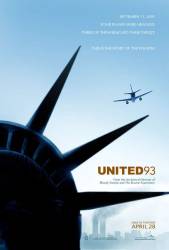Continuity mistake: At the end, during the fight scenes in the first class cabin, the number of overhead compartment doors that are open changes.
Continuity mistake: After the hijackers have taken over the plane, the blond flight attendant's hair, styled in a French Twist, keeps changing from messy (presumably from the chaos) to as smooth and neat as when she boarded the plane. She's never offscreen long enough to have simply fixed it. Not until the passengers revolt does it remain disheveled.
Continuity mistake: United 93 is cleared to depart from runway 4L at Newark. However, you can see the terminals out the right side of the aircraft, indicating that it is departing to the southwest, on runway 22R.
Continuity mistake: During the hijack, a female passenger goes to help another one who has been stabbed in the neck, bleeding profusely. When she returns to her seat, she has no blood on her.
Continuity mistake: In the Boston ATC sequence, the radar screen shows American 11 at a flight level of 350 (35,000 ft) this alternates with a flight level of 310 between shots.
Continuity mistake: When United 93 is in the air, the terrorist in the last row of the first class cabin has his brown jacket alternately zipped/unzipped between shots.
Continuity mistake: Shortly after take off from Newark the plane has changed from a Boeing 757 to an Airbus plane as evidenced by the design of the winglets.
Continuity mistake: In the beginning of the movie, when we see a hurried passenger trying to get through the security check, he takes his pocket change out of his pocket and puts it on top of the scanner. In the next shot, the money is gone and there's a purple tray instead.
Continuity mistake: Throughout the film if you look at the terrorist that wears the black polo shirt with the lines across it, the red bandanna keeps changing position, from thin and covered in hair, to thick with no hair covering.
Continuity mistake: In both the exterior shots during the film and in real life, the Boeing 757-222 (N591UA) operated by United Airlines is shown to have 2 doors forward of the wing. In the interior shots, the front door is shown, but between the first class cabin and the economy class cabin, there is just a partition, no door.






Answer: At the time of the 9/11 incident, certain type utility or pocket knives like the ones the terrorists brought on board were not illegal. Airport screeners had more leeway then about what type of knives, tools, or other gadgets they allowed passengers to carry on board. Since then, the restrictions are far more stringent.
raywest ★
I can attest to this as my father traveled on aircraft with his pocket knife multiple times before 9/11. As long as it was under a few inches; it was more viewed as a tool than a threat to the aircraft.